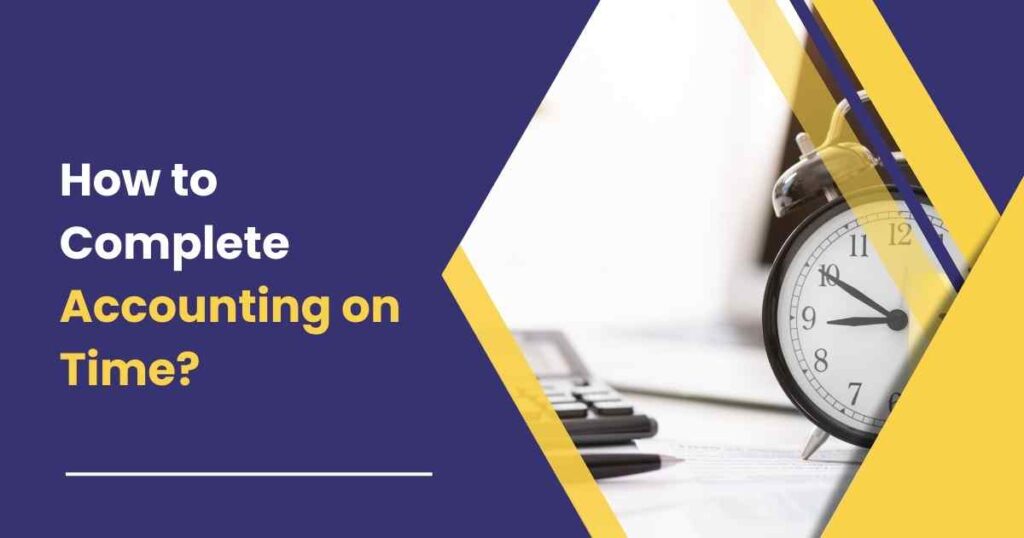Timely accounting is crucial for businesses. Missed deadlines lead to penalties, damaged credibility, and financial disorder. Despite knowing its importance, accounting tasks often end up on the back burner.
This article will provide a step-by-step guide to stay on top of your accounting, avoid delays, and get it completed on schedule.
Step 1: Create a Consistent Accounting Schedule
The first step is to establish a regular calendar for doing your accounting tasks.
- Set up specific days and times each week when you will dedicate 1-2 hours to working on accounting. Mark these on your calendar and treat them as serious commitments, not optional extras.
For example, you might block off Tuesday and Thursday mornings for accounting work. Or choose whichever routine makes most sense for your business needs and capacity.
- During these sessions, aim to complete frequent accounting activities like:
- Entering expenses
- Paying contractor invoices
- Invoicing clients
- Calculating employee payroll
- Performing bank reconciliations
Additionally, establish monthly, quarterly and annual accounting dates:
- Monthly: Reconcile bank statements
- Quarterly: Calculate estimated taxes
- Yearly: Prepare financial statements for tax filings
Committing to a solid accounting schedule prevents vital tasks from slipping through the cracks when you get busy. By prioritizing accounting time on your calendar alongside other crucial commitments, you can chip away at tasks consistently. This avoids an overwhelming backlog of unfinished accounting later.
Step 2: Use Checklists to Track Required Tasks
Now that you have designated accounting time scheduled, you need to utilize checklists to stay organized across all required tasks.
Create the following:
Master Task Checklist
Your master list should include any tasks that need to be completed on a very frequent basis, such as:
- Paying contractor/supplier invoices
- Sending client invoices
- Tracking business expenses
- Calculating and processing payroll
- Performing bank account reconciliations
Recurring Timeline Checklists
You should also construct timeline-based accounting checklists that align with key deadlines, for example:
Monthly:
- Reconcile bank and credit card statements
Quarterly:
- Calculate estimated quarterly taxes
- Evaluate sales tax requirements
Yearly:
- Gather income and expense data
- Prepare financial statements
- Submit tax return documentation
Post these comprehensive checklists near your workspace and check off items as you move through them. These will ensure no critical tasks get missed or overlooked.
Step 3: Leverage Accounting Software
While checklists, calendars, and vigilance will take you a long way, accounting software saves the most time. Instead of tracking everything manually across spreadsheets, invest in a cloud-based accounting platform like QuickBooks Online or Xerox.
The right software centralizes your processes and includes features like:
- Automated bank/credit card imports rather than manual entry
- Customizable invoices
- Expense tracking
- Reporting dashboards
You also gain useful automation options:
- Set scheduled transaction reminders tailored to your unique deadlines
- Establish automatic rules
- Receive notifications when income/expenses vary by a certain percentage or amount compared to previous periods
Leveraging software minimizes human error, reduces tedious data entry, and enables you to scale your accounting systems as your business grows.
Step 4: Outsource Complex Processes
Some accounting activities call for specific expertise, like payroll taxes or corporate filings. Or you may simply lack capacity in-house to handle all tasks efficiently. In those cases, don’t hesitate to call in reinforcements!
Outsourcing options include:
- Hiring a bookkeeper for recording transactions
- Using an accountant for compiling tax documentation
- Working with a payroll provider
- Partnering with a CFO advisor for high-level analysis
The key is clearly defining responsibilities between internal team members and external partners. Maintain open communication channels and ensure outsourced resources understand:
- Expected timelines and deadlines
- Scope of work
- Tools and software used by your business
Managed well, outsourcing alleviates overload on your internal capacity, while also giving you access to elevated accounting expertise.
Conclusion
By implementing a few fundamental practices like consistent scheduling, detailed checklists, workflow automation, and strategic outsourcing, businesses can eliminate accounting delays. Don’t let the idea of getting your accounting done on time feel daunting. With the right systems and support team, you can take control of your financial processes.
FAQs
Consistency matters most. Schedule whatever regular frequency makes sense realistically for your bandwidth – even 30-60 minutes per week. The key is to protect this accounting time fiercely rather than skipping it.
At minimum, seek software with bank/CC imports, customizable invoices, expense tracking, and reporting dashboards. Platforms like QuickBooks Online and Xero offer excellent baseline functionality.





